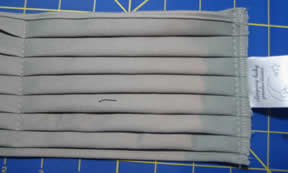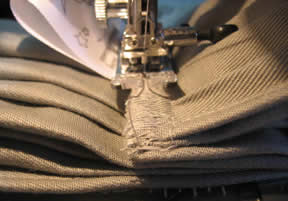For 56-60" wide fabric:
Instead of making just one
sling, you can buy 2 to 2.5 yards of fabric, cut in half down the foldline,
and voila, you have two pieces of 30" wide fabric, enough for two slings.
You can then keep one to give as a gift to a new mom, or have one for yourself
and one for a spouse, or one to wear and the other to wash (especially helpful
in the early, poop-blowout-prone days). |
For 45" wide fabric: |
If you are using a bottomweight (see the Fabric
FAQ for details), just
cut 15" off one edge and hem the sides (as in the directions below). You can
use the extra 15" strip to make a doll sling or some accessories to go with your
sling.
If you are using a lightweight or calico fabric, try
these directions!
they make a safer sling of a more useful width than the just folding it in half.
If you have only one length of 45" lightweight fabric, you can sew the edges
together and then "quilt" the
layers for more strength. Do keep in
mind that while you *can* use a 22" wide
sling, it's not great for smaller babies -- definitely not to be used for a
kangaroo carry, as that requires a much wider swath of fabric to be secure.
22" is
doable for a hip carry with an older baby or toddler, and a cradle or tummy-to-tummy
for a very small baby, but not great for much else. (Please feel
free to email me if this isn't clear
enough!) If you have to make it 22" wide, I'd suggest using Corrine's
"Adjustable pouch" directions instead, as the built-in pouch seat
makes it more secure with that width of fabric. |
For either width of fabric... |
Hemming:
Hem one short side and the cut edge -- you may hem the selvage, but as long
as the selvage is strong, it's okay if you don't. I use a 6mm
hemming foot, which works well with most fabric weights. Having the hem on
the outside makes it less likely to dig into you or your child when you're wearing
it. I really recommend using a hemming foot if you can get your hands on one
(it makes it so much faster and easier!) but if you can't find one, you can either
turn and press the hem, or do what I used to do, which is fold the hem, hold
it with your fingers while you sew through it; stop when you get to your fingers
(ouch!), refold about 10" below that, etc. It takes a lot longer that way
than with a hemming foot.
If you are using a 45" fabric, I would recommend this
method. Or you
can fold it in half, put the printed sides together and sew around the edges,
leaving a space for turning. Turn it right-side-out and topstitch the edges,
including the gap used for turning. |
Pleats:
* there are almost as many ways to fold a sling to put it through the rings
as there are people who sew them! Please don't feel that you need to use pleats
in your sling. Here's a page I just made with some folding
variations -- many
of which are in use by other WAHMs who make slings. *
Here are some newly-revised step-by-step illustrated
pleating directions.
Using this method, it's simplest to pin as you
go, at least on the raw edge. Or, from a suggestion by Deanna M., you can use
tape to hold the pleats in place. Masking tape, which comes off easily, would
also be a sewing aid if you have trouble sewing straight lines. I usually put
pins at the very top of the pleated section, and again at 5-6"
down, then sew perpendicuarly across the pleats at 1/2" and 5-6" from
the top, with a basting stitch that I can take out later, so it looks neater. Questions?
Check here. |
Sewing in the rings: (click
any image for a larger version)
 |
 |
| You can see the pleats basted in (stitching on the left and right is about
6" apart, because this sling will have the thicker nylon SlingRings),
and the position of the needle and fabric in the machine as I prepare to zigzag
over the raw edge. |
Showing the zigzag I use to finish the raw edge of the sling. I use a very
wide, close stitch (on my machine, the width is set to 7 and the length to 1.2,
although the numbers on your machine will probably be different), so that the
edge is completely enclosed with thread. This is far easier to sew through than
an edge that's been turned under, and it keeps the raw edge from fraying just
as well. |
 |
 |
| Showing the "right" side of the pleats, basted in
and with the raw edge zigzag finished -- all the folds appear to be the same
width, although the back shows otherwise :) |
Showing the "wrong" side of the pleats, basted
in and with the raw edge zigzag finished -- you can see the first, large fold
at the top, and the subsequent pleats towards the bottom. |
 |
 |
| First stitching line for sewing the two rings in -- note that
I am sewing just to the right of my basting stitches, and on top of the zigzag
stitch that keeps the raw edge from fraying. This is much easier to sew through
than folding the raw edge under (which works only with extremely thin fabrics)
and is just as tidy when in use. |
Finished -- back side. Between this picture and the last, I
have flipped the sling over and sewn another stitching line about 1/2" from the
first (from the "right" side of the sling), then a line of decorative stitching
between the two. I have also removed the inner line of basting stitches ( the
ones that were approx. 6" from the edge). |
 |
|
| Finished -- "nice" side. You can see the two lines of stitching
with the decorative stitch in the middle, and if I had a better macro shot, you
would also be able to see the holes left from the basting stitches. (Those disappear
when the sling is washed.) |
Optional: add a zippered
patch pocket to the tail of the sling. |
|
Threading your sling and babywearing:
I finally got around to adding illustrated
directions on threading and wearing your sling. Please check them out! If
you have any questions, please email
me! To thread your sling, place the ring-end on your shoulder so that the
rings hang a little higher than your armpit. Reach around, take the other end,
making sure that the fabric doesn't twist, and bring it through both rings from
underneath. Now thread the fabric through the bottom ring. Adjust to fit.
|
